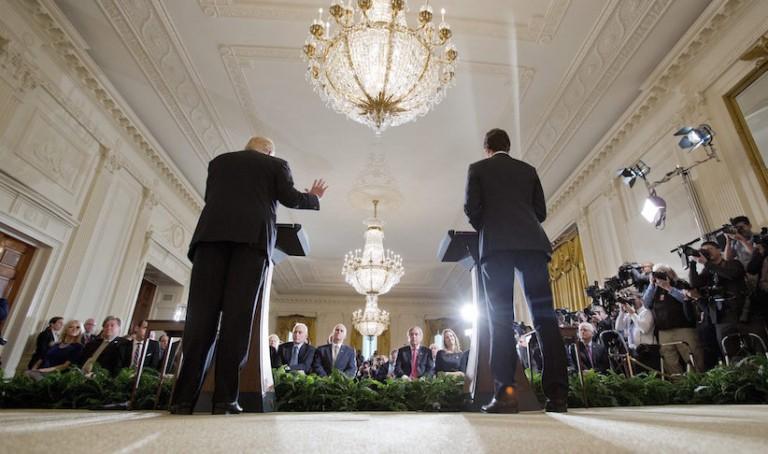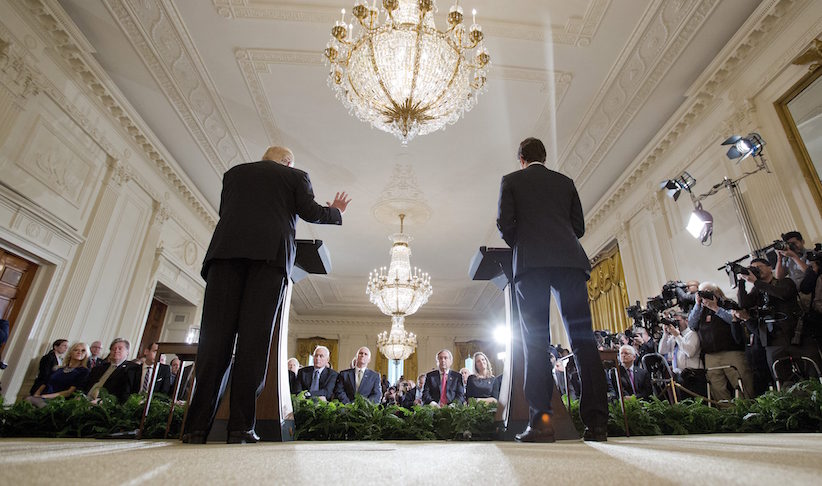Trudeau’s three-step plan to stay under Trump’s radar
This meeting was never about substance, and instead all about relations. The goal for Trudeau was simply avoiding the Trump Twitter hit list.

President Donald Trump and Canadian Prime Minister Justin Trudeau during a joint news conference in the East Room of the White House in Washington, Monday, Feb. 13, 2017. (AP Photo/Pablo Martinez Monsivais)
Share

The obsessive media focus on the first handshake—6.5 seconds—was the best indication of the collective anxiety leading up to the Trump-Trudeau meeting. Would the germaphobic President try to assert his dominance over the Prime Minister as he did with his Supreme Court nominee Judge Neil Gorsuch, using a fixed hand clasp followed by a condescending pat and then three quick, hard yanks? Or would Mr. Trump hold Mr. Trudeau’s hand in captivity as he did with the Japanese Prime Minister Abe, as if waiting for a ransom to be paid before he released it? Abe was so taken aback by the gesture that when he finally got his hand back he looked off camera, presumably to an aide, and gave a hammy, undiplomatic eye roll, as if he was on an episode of Three’s Company, not at “the very famous White House,” as President Trump had called it. Neither happened.
MORE: How memeable moments could help world leaders with their Trump problem
“Handshake One,” on the doorstep of the West Wing on a blustery mid Monday morning, was a reconnaissance affair, both men gripping firmly and quickly, hands remaining equidistant between the two so no one won any perception of a tug of war. Mr. Trump went in for a left-handed, high shoulder pat, to which Mr. Trudeau, ever the counter puncher, instinctively swung his arm up to clasp the President’s right upper arm. Then they dropped back into First Handshake position. Three seconds. For a moment more they heartily shook hands and Mr. Trudeau appeared to stick out his lower jaw, but it was hardly noticeable except when the thousands of digital pictures emerged afterwards. Another second and half passed. They smiled in that Alpha male style, all confidence and pent up energy and turned to the cameras while exchanging pleasantries. A moment more just to let history have it’s due. Two seconds more and it was done. Then the wind blew, whipping open the President’s suit jacket and blowing the two heads of famous hair, and they ducked inside and began.
Handshake Two inside the White House, as the two were seated in chairs beside each other, was a passing matter by contrast, a mere two seconds. The President initiated the shake for the cameras and Mr. Trudeau, caught for a micro-moment off guard, happily obliged. Again, for the Kremlinologists of Handshakes, as writer Chris Turner called the media on Twitter, there was debate as to who had asserted dominance in that moment and what impact it might have on U.S.-Canadian relations. Articles were written. Twitter was alight. Admittedly, I got so caught up on the asinine obsession over the handshake that I actually found myself reading a 2012 study from the Journal of Cognitive Neuroscience called “The Power of a Handshake: Neural Correlates of Evaluative Judgement in Observed Social Interactions.” When I read that the authors had concluded that the “nucleus accumbens showed greater activity for Handshake than for No-handshake conditions, ” I realized I had no bloody idea what they were talking about and I was clearly out of my mind. When U.S.-Canada relations, worth $2 billion in two-way trade every day, depends on the minutiae of a handshake, things must be really bad. Yet the truth is, as the meeting revealed, they are not bad at all.
In fact, the Trump-Trudeau meeting went about as well as could have been hoped by any partisan. The goal, as a source in the Prime Minister’s office told me before the meeting, was simple: keep trade flowing. “The key is stability on the economic front. It’s sending a clear message they [Trump and Trudeau] both realize how many jobs in each of our countries are dependent on the positive trade relationship.” Well, mission accomplished. The President recited the libretto of mutually beneficial trade perfectly, saying at one point that trade across the border would be even better and faster. “We have a very outstanding trade relationship with Canada,” Trump said. Good stuff. When President Trump said he would be “tweaking” NAFTA, and that the situation was much less “severe” than Mexico, there was collective wiping of the brows in the Canadian delegation. It was a long way from Trump’s campaign rhetoric of ripping up the worst trade deal in history. Of course, it is too early to call this long-term success. That will be determined when the actual negations on issues like softwood lumber, or country of origin labeling begin, but this is a good start.
This was never about substance anyway, but all about relations. The goal was simply to avoid ending up on the Trump Twitter hit list: get in, make nice, and get out without any collateral damage. Trudeau avoided picking any fights over Donald Trump’s controversial immigration ban, carefully responding to a question about the order by saying he was not going to lecture another leader on domestic politics. Still, he didn’t play down Canada’s commitment to let in 40,000 Syrian refugees—but he didn’t flaunt it either.
And now, let’s pause for those on the left to make the case of appeasement, cowardliness, for not standing up to Trump’s outrageous anti-Muslim immigration ban the way, say, Angela Merkel did, or to denounce Trump’s stance on climate change and any number of other Trump policies that muss their ideological hair. And let’s pause, too, for the right to say that praising Trudeau’s balancing act is some kind of pro-Liberal apple-shining. The truth is, politicians of all stripes recognize the need for a functional Canada-U.S. relationship, and the first meeting between these leaders was not the time for public grandstanding. There was simply no upside.
The Trudeau tactics were based on the premise that President Trump’s skin is thinner than a coat of sunscreen. The PM had to assure the President that he was not the “leader of the liberal global resistance” to the Trump Agenda, as the Washington Post dubbed him. That might play well domestically, but it is a disastrous brand for a first White House meeting. Trudeau did everything he could to act demurely on any provocative issue, from defence to immigration.
That was tactic one: Find Common Ground. Justin Trudeau is basically fourth Dan, black-belt empath, who the PMO believes can relate to anyone, and they knew he could make their ideological differences fade away by talking about raising the middle class up and finding jobs for workers. That’s why the PM’s speech was peppered with one subject: jobs.
Tactic Two: Get Inside the Family Circle. The Trump administration is a family affair, and the key to building Trump trust is to connect with his family. That’s why it was so savvy to focus on Ivanka Trump, who the President has fiercely defended on Twitter when Nordstrom dumped her fashion line and whose husband. Jared Kushner, is the President’s senior advisor. Ivanka is widely seen as having a powerful influence on the President and she has long talked about the role of women in business. When the Prime Minster and the President held a roundtable for female CEOs, Ivanka sat beside Mr. Trudeau and was the third person to speak, after the two leaders. It was a brilliant way for Trudeau to look as if he was, literally, inside the family circle. For the President, who has a long and sordid series of controversies surrounding his attitude towards women, it was pure, unabashed damage control. That the consequence of this tactical play was something called the Canada-United States Council for Advancement of Women Entrepreneurs and Business Leaders is a bonus. Highlighting the need for more women in positions of power is a good and necessary thing, but the political usefulness of the meeting for both Trump and Trudeau overshadowed, for now anyway, its worthy mandate.
The final Trudeau tactic was a straight vanity play. He gave the President a 1981 picture his father and a young Donald Trump together, both decked out in tuxedos at the Waldorf Astoria in New York. The Prime Minister was receiving an award. “What a great picture,” Trump remarked when he saw it. Hard to miss the symbolism: a longstanding family connection, Mr. Trump in a most flattering light, a friend of the Trudeaus long before he was the President. Nothing like a touch of nostalgia to fill in the political void. It was an impeccable, Mulroney-esque charm offensive: Always make it personal.
However, the best measure of success was, perhaps, the U.S. headlines. Or, more specifically, the lack of U.S. headlines. Within minutes of the Trudeau-Trump press conference, while the Canadian media were hyperventilating over handshakes and syllables, I looked at the web sites of CNN, Fox News, the New York Times and Politico, some of the biggest U.S. media outlets. The visit was barely visible, already deeply buried under headlines and stories about national security advisor Michael Flynn and if he will survive in his current job. By 9 pm, it was as if Justin Trudeau was never there at all. The internal Trump drama and White House intrigue had once again engulfed the news cycle. That’s exactly where Canada wants to be in the first month of the most volatile presidency in generations: right under the radar.